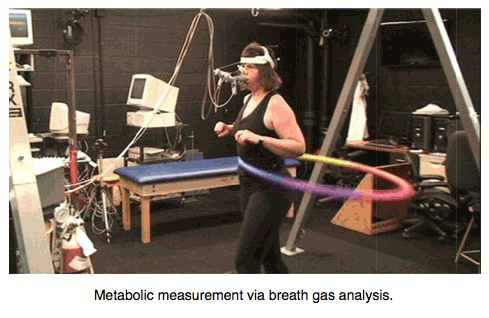University Study Confirms: Powerhoop ® reduces waist size
Powerhooping may be fun, but it’s a fitness activity that can be taken seriously. A new study by researchers at Canada’s University of Waterloo Spine Biomechanics Laboratory, one of the world's foremost sports medical research facilities, has now confirmed that regular Powerhooping causes the waist to shrink.
The subjects were fourteen mildly overweight women who used a Powerhoop (a specially sized, weighted and padded workout hoop with a wavy interior) for fifteen minutes per day, five days per week, over a period of six weeks. The researchers collected several types of data, including calories burned, subcutaneous fat measurements, subjects’ body measurements and muscle activation.
Here are the most important findings from the study:
• On average, participants experienced a significant decrease in waist and hip circumference, and waist-to-hip ratio. Average reduction in waist size was 3.35 cm,with three of the fourteen subjects losing between 5 and 7.5 cm around the waist.The hips also shrank, but not as much. (The "hourglass shape" was therefore accentuated.)
• Calorie expenditure during static hooping varied from 300 to 420 kcal/hour: higher for inexperienced users and when the hoop was used in the non preferred”direction.
The researchers also made a surprising finding regarding the distribution of fat on the body. On average, the subjects had slightly more subcutaneous fat (under the skin) after the study period, despite the fact that their waists were narrower, their muscles stronger and their bodies lighter. One possible interpretation is that the amount of “belly fat” (visceral fat stored deeper in the abdomen) had decreased and redistributed itself, possibly as a result of the powerful “massage” effect from the hoop.
This would be a sensational finding if proven to be true. Visceral fat is difficult to burn, and is linked to coronary disease, type 2 diabetes, insulin resistance, and other obesity related diseases.
For now, the question will have to stand with a big question mark after it until the researchers have done a follow up study, for example, using bioelectrical impedance analysis to measure the amount of visceral fat before and after the trial period.
Lastly, Powerhoop was compared with a conventional hula hoop using a technique called electromyography, which calculates the impact of the hoop as percentage of the maximum voluntary contraction. Not surprisingly, the Powerhoop produced higher activity in every muscle compared to the conventional hoop. In the Rectus Abdominus (the main part of “the abs”), muscle activity was up to 70% higher.
Source:“Analysis of physiological and biomechanical variables over a 6 week trial using a Powerhoop together with investigation of mechanisms of hooping.” Department of Kinesiology, University of Waterloo, Waterloo, Ontario, Canada N2L 3G1

If you would like to know more about THE PHYSIOLOGICAL EFFECTS OF POWERHOOPING and how classes may benefit you, you can learn more HERE.


